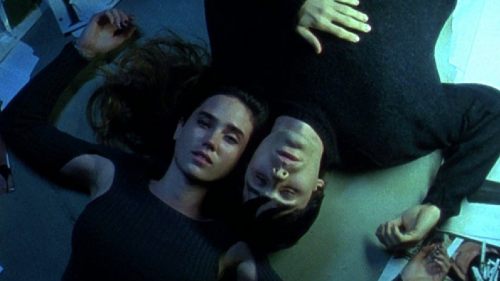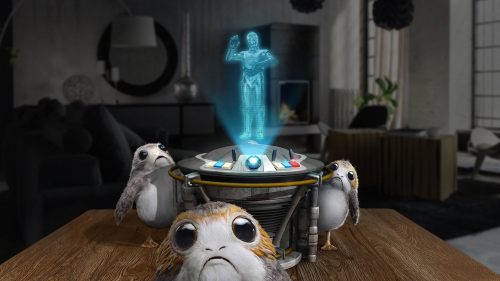The History Of NOAH’s Watchers, The Creatures That Scared The Hell Out of ILM
One of the best things about Judaism is how much scholars and rabbis like to argue about what things in the Hebrew Bible mean. It's cool, and very different from the rigidly defined dogma of too many Christian splinter groups. There are vast reams of literature and entire schools of thought about what different passages mean, why certain words are used and what the general intentions of sentence are. This is called the Midrash, and it's the sort of thing nerds obsessed with expanded universes and tie-in books and continuity will understand, as the Midrash takes into account extra-canonical sources like The Book of Enoch and The Book of Jubilees. While your average Baptist will plug up his ears before hearing a differing opinion on the Bible, a good Jew will go toe to toe with you using his understanding of Hebrew, history and metaphor.
One of the things that has caused generations of argument and theory is the word "Nephilim." It's used twice in the Hebrew Bible, both times in the Torah (that would be the first five books, aka the Books of Moses). Once is in Genesis:
Now it came about, when men began to multiply on the face of the land, and daughters were born to them, that the sons of God saw that the daughters of men were beautiful; and they took wives for themselves, whomever they chose. Then the LORD said, "My Spirit shall not strive with man forever, because he also is flesh; nevertheless his days shall be one hundred and twenty years." The Nephilim were on the earth in those days, and also afterward, when the sons of God came in to the daughters of men, and they bore children to them. Those were the mighty men who were of old, men of renown.
The other time is in Numbers:
So they gave out to the sons of Israel a bad report of the land which they had spied out, saying, "The land through which we had gone, in spying it out, is a land that devours its inhabitants; and all the people whom we saw in it are men of great size. There also we saw the Nephilim (the sons of Anak are part of the Nephilim); and we became like grasshoppers in our own sight, and so we were in their sight.
And that's it for the canon. But every word of the Hebrew Bible (known as the Tanakh) has been pored over, dissected and discussed, and many thinkers and scholars have devoted much time to figuring out just what the Nephilim were. A lot of this discussion centers on just who the sons of God were - were they angels? Were they the children of Seth, brother to Cain and Abel? Pretty much everybody agrees they were big - giants, even - but what are we to make of them?
One of the most popular answers comes from The Book of Enoch, a non-canonical religious text from maybe 200BC, suppposedly written by Noah's great-grandfather. That book has a large section about the Nephilim, who are the offspring of angels known as the Watchers, who fell from the grace of God:
And it came to pass when the children of men had multiplied that in those days were born unto them beautiful and comely daughters. And the angels, the children of the heaven, saw and lusted after them, and said to one another: 'Come, let us choose us wives from among the children of men and beget us children.' And Samyaza, who was their leader, said unto them: 'I fear ye will not indeed agree to do this deed, and I alone shall have to pay the penalty of a great sin.' And they all answered him and said: 'Let us all swear an oath, and all bind ourselves by mutual imprecations not to abandon this plan but to do this thing.' Then sware they all together and bound themselves by mutual imprecations upon it. And they were in all two hundred; who descended in the days of Jared on the summit of Mount Hermon, and they called it Mount Hermon, because they had sworn and bound themselves by mutual imprecations upon it."
So basically The Watchers got horny and boned human women and had children with them, sometimes known as the Nephilim, sometimes known as Anakim. The Book of Enoch became very important to early Christian doctrine, and it informs a lot of demonology -the famed Azazel makes his first appearance there.
Darren Aronofsky's Noah touches on this stuff in his use of The Watchers. For instance, while Azazel doesn't appear in the film his Watchers helped man create industry, much as Azazel taught man to smith metal and make armor. Samyaza does show up in the movie, and he is the leader of the Watchers.
But these Watchers didn't fall because they were horny. They fell by choice - they had been watching over Adam and Eve in the Garden of Eden and grew to love them. When they were exiled the Watchers opted to come to Earth and help the children of Adam, falling in fiery balls that crashed into and merged with the ground. Covered in stone they are, at the beginning of Noah, few in number and living in a blasted wasteland far from humans, who they feel betrayed the Creator using the knowledge and ability the Watchers themselves granted.
When I sat down with Aronofsky I asked him about his approach to the Watchers, who play a major role in the film but who are presented in a way that is unique and unlike anything found in traditional thinking:
We were very interested in everything we could read about the Nephilim, and we were inspired by all of it. But we needed to find a way to do something original. When we wrote this seven, eight years ago there weren’t that many giants on the screen and since then there have been all different sorts of things.
We struggled for a long time figuring out how to do them. We knew there was some angelic energy to them, and we knew there was some type of earthly form to them, but we want to try and capture the themes of the movie in these creatures. We didn’t want them to just be cool creatures. There’s this really big theme about justice and mercy going on in the film where Noah and God move from justice towards mercy, and we flipped that for the Watchers. We made these incredibly merciful characters move towards justice. Then we tried to figure out how to express their story in a physical form. The idea of these angelic creatures mating with earthly forms and making something else became, through metaphor, the idea of these angelic forms captured by and forming with the earth and becoming imprisoned by the earth.
The big image we had stuck to the wall was a seagull trapped in oil. The way the earth can destroy that type of lifeform we wanted to apply to these winged creatures. We went with six-winged creatures because the Seraphim are described as a six-winged creature. When they got encased they were able to use the wings as arms and legs.
The design that Aronofsky came up with wasn't greeted warmly by the FX guys at ILM, who were tasked with bringing them to life:
When we started to come up with these designs we scared the hell out of ILM. They were saying, “How are we going to do this? They’re so bizarre.” When we did motion capture everything ILM gave me was this very realistic, human-moving giant. And I said, “No, I don’t want that. I want to move away from that as much as we can.” So we started working on walk cycles, and I brought in all these ballet dancers I know and we attached yoga blocks to their feet and gave them crutches and created this painful, crippled, dragging feet type of feeling to visualize the pain of the characters, that they were malformed and captured.
Aronofsky's Watchers are one of the strangest parts of the film. Their form is so odd that some have been taken right out of the movie by them. They don't correspond with what we understand as Biblical images of angels, and in fact Paramount has really kept them out of all the marketing (the only image of the Watchers I could find online comes from Aronofsky's Twitter feed, and the rock monster is not easy to see in the picture). To me they're part of what makes Noah such a challenging work; Aronofsky has created creatures so weird I've heard them compared to both Transformers and Ents, diametrically opposed beings. But beyond their strangeness, the Watchers work as characters, and by the time the Flood comes to wipe out all life on Earth (some midrash speculates the Flood was partially intended to get rid of the Nephilim), you'll feel the full impact of their journey back to grace.



_500_281_81_s_c1.jpg)